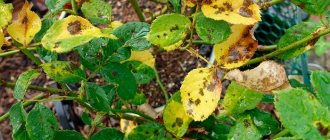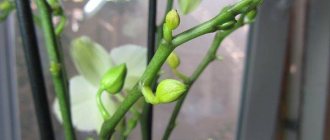When can a rose turn into a rose hip?
Varietal roses have difficulty surviving the winter in our climate. Therefore, technologists make a graft: they take a frost-resistant rose hip root and graft a varietal rose onto it. And it turns out that the root of the plant is from rosehip, and the stem is varietal (and the flowers too).
The stem of a varietal rose cannot turn into a rose hip! This is out of the question.
A rose can turn into a rosehip in only one way - when the so-called root shoot or root shoot comes from the rosehip root and from the stem BELOW the graft. These are really rosehip shoots.
Such escapes are not a restocking. But they must be removed, and cut out completely. If this is not done, the rose will eventually go completely wild and turn from a varietal rose into a rose hip.
So, if you find a suspicious shoot on your rose bush, then let's figure out whether it is a varietal one or not.
Garden roses - basic rules for growing and caring
Each plant has preferences and there are also peculiarities in caring for roses. One of the keys to successful cultivation is the correct planting location. Flowers prefer bright areas, protected from drafts and gusts of wind. Bushes should not be exposed to the sun for too long, especially for dark-colored varieties that fade easily.
The optimal temperature is +18...+25 °C; at higher values, the plant will burn the leaf blades and the flowers will dry out.
Next, you need to properly trim, water and feed the plant; these basic rules for growing will be discussed below.
Soil and mulching
The best soil is rich in humus, loose, well permeable to moisture and air. Lack of oxygen will negatively affect root development. The soil should be slightly acidic pH 6.0-6.5, for areas with cold climates, alkaline pH 7.0 is better. To increase acidity, add peat or organic matter, such as manure.
The unsuitable type of soil is swampy and too moist; excess moisture leads to rotting of the roots and death.
Between the rose bushes you can plant ground cover plants or a lawn, which will become an excellent mulch material that makes the soil loose. You can use sawdust or shavings.
Reproduction
Reproduction of bushes occurs vegetatively. For climbing and large species, the best method is to root cuttings. To do this, select a flexible, strong shoot, on which an 8 cm long incision is made. Next, the stem is secured with pegs to the ground and sprinkled with soil. Next season it can be separated and replanted.
Another option is using cuttings. To do this, in spring or early summer, select strong stems without damage and cut them into pieces 15-20 cm long. The upper cut should be at a right angle, and the lower one should be made at 45 degrees. Leaf blades are removed or shortened. Prepared seedlings can be laid out in a hole made in open ground, sprinkled with loose soil at an angle. Cover the top with a plastic or glass jar.
Next spring, the rooted cuttings can be transplanted into a flowerbed with prepared loose soil.
Shaping and trimming
In accordance with the tasks facing the florist, there are 5 types of pruning:
- formative;
- sanitary;
- for flowering;
- thinning;
- rejuvenating.
A bush planted in spring will begin active growth of shoots 2-3 weeks after adaptation to a new location. From this moment you can form a plant. Stems that are too large in size from the top must be pinched off. This must be done after the appearance of 4 sheets. In this way, the symmetry of the bush is achieved. Correction of the form should be continued until August, giving the opportunity to bloom. The first pruning is always carried out in the spring, even if the rose is planted in the fall.
Sanitation is performed after the bushes open in spring, summer and before the dormant period. All frozen and poorly developing stems are cut off. However, in the fall it is necessary to leave the shoots long, this will help prevent them from dying at low temperatures.
In some bushes, sprouts with small leaves may begin to appear at the grafting site; this is wild growth. It needs to be cut off at the base of the root collar, cleared of soil.
Wilted flowers are removed, this helps maintain a neat appearance. You need to cut above 2-3 leaves and a developed bud, the distance from it should be 0.5-0.8 cm. At the end of summer, dry flower stalks are not cut. Removing them can cause new shoots to grow that are poorly prepared for winter.
Summer pruning is done with the goal of cutting off all weak shoots, as well as fatty shoots that create a thick bush. A plant with a large number of thin branches becomes easy prey for pests. Blind ones without buds also need to be shortened, leaving 4-5 pairs of leaves.
Anti-aging procedures are necessary for mature bushes to prolong their life in the garden. Plants need to be heavily pruned, but this should be done in several stages so that the bush has time to adapt before autumn. It is also necessary to dig up and cut off the dry parts of the stems.
Watering
An adult rose requires a fairly large amount of water. However, at different stages of growth, the bush’s need for liquid is not the same. The greatest need for water occurs during the development of shoots, the appearance of leaves and after the first flowering. One plant requires 15-20 liters, and in hot weather watering should be increased to 2 times a week. Lack of moisture will greatly affect the stems and, especially, the flowers; they will be faded and underdeveloped.
The water should be warm; the root system of roses does not tolerate cold. It is recommended to pour the settled liquid from a watering can in a thin stream into the base of the plant, being careful not to get on the leaves. Do not moisten the soil in the heat, and do not use a hose.
Starting in September, watering must be reduced. A large amount of liquid during this period stimulates plants to grow new shoots, which do not have time to prepare well for winter and die. Therefore, many gardeners completely stop moistening the soil during this period. However, if the weather is dry and without rain, the liquid deficit should be compensated at the rate of 10-12 liters per bush once a week. This will help the roots store water for the winter.
Feeding
For proper growth and development of the plant, you need to alternate organic and mineral fertilizers. They are introduced into well-moistened soil at a distance of 10-15 cm from the root collar. After distribution, another watering is carried out.
Young and mature bushes are fed differently. In the first year of planting, fertilizers need to be applied in small quantities 2-3 times per season. More frequent procedures 5-6 times can be done in the second year of the rose’s life.
Sources rich in organic matter:
- Rotted manure can also be mixed with peat in a 2:1 ratio. Decomposes slowly, constantly saturating the soil.
- Bird droppings: A fast-acting fertilizer that is rich in nitrogen. It is better to use in liquid form at a rate of 1:10. A bucket of solution is enough for 2-3 bushes.
- Wood ash. Makes the soil alkaline.
- Compost from rotted parts of other plants.
The main nutritional chemical elements for roses are presented in the table:
| Element | Benefit | Payment deadline |
| Nitrogen | Growth of stems and foliage. | May-August. |
| Phosphorus (superphosphate) | Ripening of strong shoots. | June-September. |
| Potassium sulfate | Formation of a large number of buds, proper preparation of plants for wintering. | From early summer to October. |
| Calcium | Neutralization of acidic soils. | As needed. |
| Trace elements: magnesium, boron, iron and manganese | Increasing immunity, protection against diseases, general strengthening agent. | During the growing season. |
Plants should receive the greatest amount of nutrients in the spring during active growth and budding. In order not to make a mistake with the amount of fertilizer applied, you should fertilize in 5 stages according to the following scheme:
| Period for fertilizing | Superphosphate (g) | Ammonium nitrate (g) | Potassium salt (g) |
| Spring pruning, bud opening | 25-30. | Not included. | |
| Shoot growth | 25-30. | 10-15. | 10-15. |
| Formation of buds | 30-40. | 15-20. | |
| End of the first flowering | 10-15. | 15-20. | |
| Completion of the second wave of flower stalk formation | 40-50. | Not used at this stage. | |
The proposed substances are based on a bucket of water.
Diseases and pests
Growing roses involves timely prevention of diseases or pests. Inspection must be carried out at least 1-2 times every 7 days. This will allow you to identify the problem at an early stage and prevent the death of the rose.
All damaged areas should be removed; they should not be composted, but rather disposed of or burned.
If sanitary pruning does not help, you should use fungicides, for example, Abiga-Pik, Topaz, Skor. You can use folk remedies. The following table will help determine the cause of the plant’s malaise and find the appropriate medicine:
| Disease/pest | Signs | Elimination |
| Powdery mildew | White coating on young shoots. Curled leaves. | Carry out prevention, disinfect new plants, treat with preparations containing copper. |
| Rust | Bright orange spots near the buds. | |
| Gray rot | Mold, buds do not open and wither. | Dry the soil, remove the affected parts of the plant. Spray with a solution: 300 g of soap and 30 g of copper sulfate per 9 liters of water. |
| Black spot | Dark brown circles. | Choose rose varieties that are resistant to diseases. Dispose of dying parts. Use fungicides (Profit, Bordeaux mixture, Fundazol) |
| Burn shoots | Red streaks and frost marks girdling the stems. | Dry roses before covering them for the winter. Paint the damaged areas with water-based paint with the addition of copper oxychloride: 0.5 l 20 g. |
| Caterpillars | Holes and torn edges in foliage. | Collect by hand. Sprinkle mustard powder around the bush to repel pests. |
| Sawfly | Damaged shoots dry out. | Treat not only the affected parts, but also the ground around the rose with insecticides, for example, Iskra, Intavir. |
| Thrips | Curling and withering of young parts of the bush. | |
| rose aphid | Apply garlic solution: 200 g per liter, leave for 5 days, dilute with water at the rate of 1/4 of the resulting liquid per 10 liters. | |
| Spider mite | Web on the lower surface of the leaf blade. | Wash the leaves and treat with Fitoverm. |
All diseases affect the decorative appearance of flowers and their winter hardiness.
Preparing for winter
Covering roses is an important and responsible process, because the preparation of the plant begins even before the onset of cold weather. From the second half of August, the actions of the grower should be aimed at stopping growth. To do this, reduce watering and fertilizing, and when it rains, stretch polyethylene over the bushes. Actively growing shoots are pinched.
When temperatures drop to 0°C, roses stop growing and accumulate nutrients. Natural hardening occurs, so do not close the plants early.
The final stage of preparation is the beginning of November. It is necessary to remove the remaining leaf plates and trim the bushes to a height of 40-45 cm. Then cover with insulating material: dry sawdust, preferably coniferous, at the rate of 3 buckets per bush. You can use peat, after mixing it with sand, pine branches, or simply cover it with a layer of earth.
Sometimes they use homemade greenhouses 50-60 cm high made of metal or pipes and roofing felt. However, this type of bush insulation is not suitable for damp areas.
Roses are uniquely beautiful shrubs, represented by a variety of shapes, types and colors. With proper care and careful adherence to the recommendations, even a novice gardener will create various compositions with these plants in the garden.
How to determine that it is a rosehip shoot
Look where the suspicious escape is coming from.
If the shoot comes from the ground, then carefully and carefully dig up the graft or the soil around the suspicious shoot and see where it comes from. If our shoot does not come from the graft, but from the root, then this is a rosehip shoot.
How it all looks is shown in the figure.
If the shoot comes almost from the graft , and you find it difficult to determine whether it is a varietal or not, then observe for a week or two. If it starts to grow much faster than other stems, then 99% it is rosehip. Such a shoot must be cut out completely! If it grows like other shoots, then watch further.
What such a controversial escape might look like is shown in the figure.
If you find that a suspicious shoot is going above or below the graft
, then this is definitely not a rose hip, but a varietal rose. And here you need to understand what exactly causes you doubts. Young varietal shoots may differ in appearance from old varietal shoots. This can be either a normal feature of the variety or a consequence of improper care or stress.
Let's deal with doubts regarding appearance.
Millions of years - as if from a bush
Paleobotanists claim that rose hips appeared on Earth long before the first man walked on it. Inquisitive scientists have found characteristic imprints of leaves in sediments of the Tertiary period. And this, whatever one may say, is 65 million years old - like out of a bush! Pink, of course...
It is believed that the birthplace of rose hips is Asia. It is difficult to specify the place more precisely - there is not a single southern people in whose history there has not been at least once a mention of a rose (implying a rose hip). Cultivated varieties were grown in Babylon four millennia ago.
In 1279-1213 BC e. The Egyptians wrote about the queen of flowers on papyrus scrolls. Imagine, we are talking about the times of the great Pharaoh Ramses II. Unfortunately, history has not preserved the name of the first gardener who obtained the wonderful fragrant “dream fairy” from wild rose hips.
How to distinguish a rose from a rose hip: visual differences
Let's say you don't like leaves, a flower -
that is, something visual. The most common requests are : “it has 7 leaves” or “it has green, not red shoots”, “it has a lot of thorns”, “a neighbor said that only rose hips have 7 leaves, and she is an experienced gardener”….
These are all myths.
Now breeding offers us such an abundance of varieties that it is 100% possible to distinguish a rose from a rose hip only by comparing the varietal qualities. Therefore, look at what your rose variety looks like according to the breeder’s instructions and your bush according to its characteristics: the shape and color of the leaves, the color of the shoot.
There are three
RELIABLE ways to determine the variety:
1) The point from which the questionable shoot comes. If it's from vaccination, it's a rose. If from the root, it is rosehip. We talked about this above.
2) Flower. Rose hips are big
core and non-double (petals in one row).
3) Characteristics of the variety that are the norm. Compare the performance of the variety with your rose.
Why does a rose have 7 leaves instead of 5? Does this mean you bought rose hips?
Adding an article to a new collection
Many gardeners are sure that a varietal rose leaf should consist of 5 leaves, but another number means that you have been sold a rose hip. Is this really so, and when do you need to deal with the “wrong” growth, fearing the degeneration of the rose?
Modern garden centers most often sell roses without leaves, with stems sealed with wax, and even in pots where the grafting site is not visible. The bright picture on the package promises you a seedling of European selection, but when planted in the ground the plant produces leaves with seven lobes. What did you buy and is it worth urgently digging up the flower to return it to the unscrupulous seller?
How to distinguish a rose from a rose hip by leaves and color
Almost nothing! These criteria are NOT reliable for comparing a rose to a rose hip:
1) The leaves of the rose are dark green, those of the rose hip are light. In fact, there are varieties of roses with light foliage. And a rose could simply have chlorosis, a virus, or a lack of microelements, which is why the leaves on individual shoots also become lighter and cause suspicion.
2) The leaves of the rose are leathery and shiny, while those of the rose hip are rough, matte, sometimes with pubescence. And this sign may not work: for example, many David Austin roses have rough, light foliage.
3) The rose's young shoots are red, the old shoots are green or woody. Rose hips have bright green and thin shoots. But even here the sign fails: many climbing roses, floribundas, and Austin roses have bright green young shoots. Example in the picture.
By what criteria can you accurately distinguish a rose from a rose hip?
1) Thorns - roses are large, rose hips are small and there are many of them. But! It happens that a rosehip shoot grows without any thorns at all. This criterion cannot be assessed.
2) Flower size. Flowers may become smaller if the rose lacks nutrition/sun.
3) Please do not rely on the number of leaves on the petiole!
The story about the fact that only rose hips have 7 leaves, while roses always have 5, is a myth. Many frost-resistant hybrid varieties of climbing, floribunda, scrub, Austin, bush and groundcover varieties have from 3 to 9 leaves on one shoot. For example, the same “Canadians” on one branch on the petioles can often have 5, 7, 9 leaves at the same time. This is due to genetic memory: hybrids “remember” their wild ancestors and produce petioles with their characteristics.
Individual features of the trunks
Varieties of climbing roses are grafted onto a tall trunk.
Standard roses are the easiest to identify. They are sold formed into one stem with several branches. On each one the grafting site is clearly visible.
A climbing rose seedling has several shoots , even if they are small.
The stem (stem shoot) is always one. It is created over several years from bush rose hips, cutting off all unnecessary branches. The dog rose (Rosa canina) is most often used for this purpose. It takes 2-3 years until the variety can be grafted onto a standard.
The scion can be any variety from any group of roses that is compatible with dog rose, including climbing roses. As a result, varietal shoots do not grow from the ground, but form the crown of an artificially created tree.
Thus, the rose becomes both standard and climbing. As a rule, varieties with long shoots are grafted onto tall trunks, in which the crown begins at least 1.5 m.
These roses are the most difficult to care for. In winter, you need to cover the graft, which is located quite high. That is why in the fall the trunk is tilted so that old, stiff bushes have to be dug up. Without this you won't be able to put them down.
When planning to purchase a rose, it is better to observe them while hiding. At nurseries, boles are wrapped first, and then all other types of roses.











